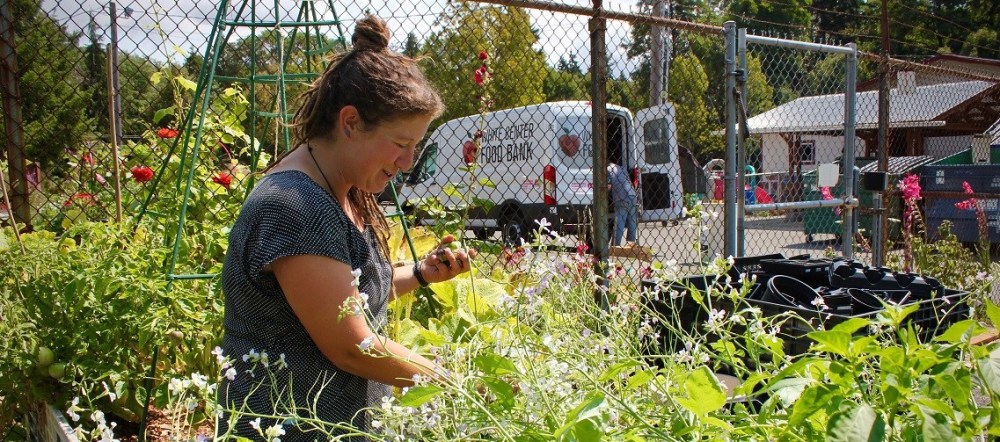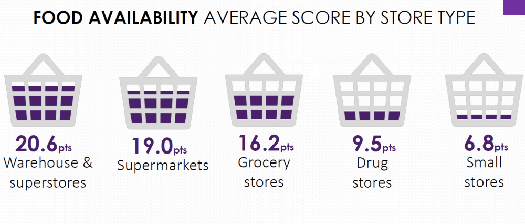How Available is Healthy Food in Your Neighborhood?

Where you live in Seattle can determine how easy or hard it can be to access healthy food. That’s one of the key findings from a new study by researchers at the University of Washington and Public Health—Seattle & King County.
The researchers surveyed 134 stores (approximately 25 percent of all food stores in Seattle), including superstores, supermarkets, grocery stores, drug stores, and small convenience stores. They looked at the price and availability of healthy foods such as fruit, vegetables, whole grains, proteins, and low-fat milk.
The researchers assigned a score based on availability of healthy foods, ranging from 0–25. They found that warehouses and superstores had more healthy foods (a higher score) than grocery stores, and drug stores had a higher availability score than small stores despite carrying no fruit, vegetables, or meat—largely due to the fact that drug stores consistently carried some eggs, beans, milk, and grains.
Food availability and geography
The researchers found that Seattleites who live near the northern and southern boundaries of Seattle have fewer options for healthy foods, had more fast food or convenience stores, and had longer travel times to stores that sell produce.
Food availability by race and household income
The researchers looked at differences in food availability by race and income. They found lower availability of healthy foods in low-income neighborhoods and neighborhoods with a greater percentage of Black or Hispanic/Latinx residents.
“Lower-income neighborhoods tend to have small stores and convenience stores, which, on average, offered fewer of the 21 healthy food items we looked for than say, a supermarket,” said Jesse Jones-Smith, Associate Professor of Health Services and Epidemiology at the UW School of Public Health.
Cost
The research team also compared the average cost of healthy food by store type and in different neighborhoods. As expected, prices were generally lower in supermarkets compared to smaller stores. Researchers also found that, except for fruit, the price of healthy foods tended to be lower or similar in lower-income neighborhoods and neighborhoods with more Black or Hispanic/Latinx residents.
Food insecurity
Food insecurity was also studied. Cost and availability of healthy food especially matter to the over 13,000 Seattleites who experience food insecurity but make too much income to qualify for food programs like the Supplemental Nutrition Assistance Program. Just last year, the network of Seattle food banks provided over 22 million pounds of food.
Researchers surveyed staff and clients of the 30 food banks that make up the food bank network to understand the extent to which the food bank network is able to serve those that are food insecure. Over 60 percent of food banks who participated in the survey said they saw a rise in visits last year.
“We heard from the food bank network that increases in need for food can come from challenges of rising housing and health care costs, an aging population, and more people experiencing homelessness,” said Kaylin Bolt, Social Research Scientist at Public Health—Seattle & King County. To keep up with demand, many food banks reported that resource constraints meant they had to reduce variety or the amount of food offered to each client.
Expanding food access
Public Health—Seattle & King County has a long history of working with partners to expand healthy food access. Recent efforts include working with food banks on nutrition guidelines. Through Centers for Disease Control and Prevention funding, Public Health is also working with partners to improve nutrition, prevent chronic disease, and reduce health disparities for African-born Americans, African Americans, and Asian Americans in south Seattle, SeaTac, and Tukwila.
View the full slides and report on healthy food availability and the food bank network in Seattle. The research team includes Jesse Jones-Smith, University of Washington, and Nadine Chan, Public Health—Seattle & King County, along with Seattle Children’s Research Institute and the UW Center for Public Health Nutrition.
Contributor Sharon Bogan, MPH is a program manager on the Public Health—Seattle & King County communications team and on the faculty at Northwest Center for Public Health Practice, UW School of Public Health. This article was originally published in Public Health Insider (2/28/19).
Local Food Resources
Community Meals
Aging and Disability Services funds community meal programs that help meet the dietary needs of adults age 60+ by providing nutritionally sound meals in a group setting. Nutrition education and social and fitness activities are also provided. For a list of meal sites and contact information, click here.
Home-Delivered Meals
Aging and Disability Services also contracts with community-based organizations to provide home-delivered meals (sometimes called “Meals on Wheels”) for older people who are unable to leave their homes to shop or prepare nutritious meals. For information about eligibility, contact Community Living Connections at 1-844-348-5464 or visit Sound Generations and Lifelong/Chicken Soup Brigade.
Senior Farmers Market Nutrition Program—provides checks for eligible older adults to use at farmers markets throughout King County. The 2019 application process opened on April 8 and will close on Friday, May 10, 2019. Applications require a postmark no later than May 10, 2019. For more information, visit www.agingkingcounty.org/SFMNP. See the related story in this issue.
Washington Basic Food Program (sometimes called SNAP) helps low-income people make ends meet by providing monthly benefits to buy food. For more information, click here.
Fresh Bucks doubles the buying power for Washington Basic Food Program. SNAP/EBT cardholders who purchase fresh produce at participating Seattle and King County farmers markets and farm stands. For more information about Fresh Bucks, click here.
![Aging & Disability Services for Seattle & King County [logo]](https://www.agingkingcounty.org/wp-content/themes/sads/images/seattle-ads-logo.png)
